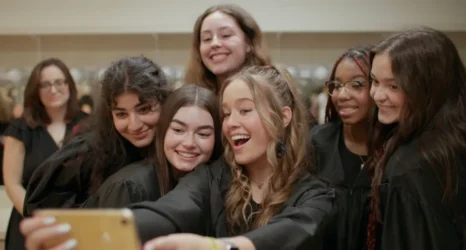The Danish Girl takes the “touchy” subject of transgender artist Lili Elbe’s life and renders it into a beautifully artistic film. However, rather than unraveling the complexities of transgender identity, the film focuses too literally on touching, on the feel of fabric, hosiery, skin, lipstick, high heels—as if one can “cross” to “the other side” of gender with the right clothing and make-up.
As Rani Baker writes in a post on Medium, “The protagonist is seduced by the clothes.” Noting stockings and hosiery appear in 14 scenes, Baker contends that the film functions more as “cross-dresser porn” than what director Tom Hooper claims is a film about “reclaiming trans history.”
An adaptation of the novel The Danish Girl by David Ebershoff, which itself was a fictionalized account of Lili Elbe’s life, the film, which is in theaters now, offers a male gaze on Lili Elbe. Hooper’s directorial gaze and Eddie Redmayne’s performance as Einar Wegener (at the outset of the film) and Lili Elbe (the woman Einar transitions into) plays as just what it is: a male performing as female to a male gaze (oh, look at this bent leg here, these downcast eyes, this coy smile, this submissive mincing walk).
As AJ McKenna laments, “Hollywood seems to prefer to remain conservative: Trans women in the movies are still men trying to be women.” Asking why Hollywood would choose to profile Lili—out of all the trans people they could have considered—McKenna insists it’s “because of how she died. You can’t make a Hollywood movie about a trans person without there being a tragic, Oscar-baiting finish… [a] tragic trans ending.”
As both Baker and McKenna explain, the film obscures the real story of Lili on many levels, from her birth as an intersex baby to the fact that she died from a uterine transplant. To be fair, the film touches on each of these points, but ultimately skirts around them. As McKenna puts it, “Isn’t it just too perfect, people? She tried so hard to be a real girl but she died in the process, because her body rejected the womb,” something McKenna characterizes as furthering the notion that “all trans people can achieve is artificial, a fantasy brought to a crashing end on the harsh blocks of ‘biological reality.’”
How different would the film be if a female or trans gaze was directing the camera movement, lighting, costuming, casting and so on? What if a trans actor played Lili? This is not to say that a woman would necessarily give us a more trans-positive tale that hewed more closely to Lili’s real life, but I would bet my stockings that a feminist director would have offered a much different take—perhaps even one that included the bisexuality of Gerda Wegener, Einar’s wife. Though the film gives us a rich representation of Gerda as Einar’s spouse and Lili’s support system, critics have not focused much on how it showcases Gerda’s struggle to support the person she loves.
Alicia Vikander is amazing in the role of Gerda. Capturing the latent feminist sentiments of the film, she gives us a woman-as-artist who understands what Judith Butler much later came to name the performativity of gender, and Laura Mulvey revealed as the pervasive power of the male gaze. At one point, while painting a portrait of a red-cheeked man who is clearly uncomfortable with her confidence, Gerda quips, “It’s hard for a man to be looked at by a woman. Women are used to it, of course, but for a man… [to] submit to a woman’s gaze. It’s unsettling.” Gerda continues, “I believe there’s some pleasure to be had from it, once you… yield.” Gerda is depicted in some ways as a radical character in the film—her sexual appetite, her confidence and her support of Elbe mark her as a trans ally—yet, rather than enriching the film by also representing her real-life bisexuality, she is ultimately shown as searching for evidence of homosexuality within Einar. Intriguingly, actor Eddie Redmayne calls this conflating of gender and sexuality his “greatest ignorance” prior to the film, admitting that he didn’t realize “you can be gay or straight, trans man or woman, and those things are not necessarily aligned.” While the film acknowledges that gender and sexuality are not inherently connected, it stops short of any radical uncoupling.
While both Hooper and Redmayne speak of gender in progressive ways, with the former stating that “gender is on a spectrum” and the latter calling gender something “fluid” that “needn’t be labeled,” the film lacks the complex exploration of gender and sexuality I was hoping for. Or, as Chloe Tse puts it in her review for The Feminism Project, the “film was made pretty easy to swallow for most audiences.” Indeed, moments that could have been played to more political—and contemporary—effects, such as when Lili is nearly beaten in a park by two men, are glossed over. Whether these men are driven by homophobia or transphobia is not made clear, obscuring the contemporary violence and transphobia that lead to at least a dozen trans deaths per year.
This heternormativity also most certainly shapes what Hooper, the film’s director, refers to as the problematic lack of “opportunity for trans actors to play cis and trans roles.” Noting, “I worked very hard to audition and meet trans actors in London where our film was based,” and citing his casting of two trans actors in the film, Hooper seems to understand why there was such backlash over the casting of Redmayne.
Casting is political, and the criticism of casting cisgender actors to play transgender characters is important and valid, as trans writers and activists like Paris Lee make clear. Though Lee is encouraged by the fact that people in casting claim “their first choice is to cast trans people in trans roles nowadays,” we must also bear in mind that Hooper had to fight for seven years to get The Danish Girl made. Though it would have been wonderful to see a trans actor in the role of Lili, and though it would have been nice to see more attention paid to the hidden stories of these characters’ lives rather than yet another tragic-queer ending, it is nevertheless positive that such films are being made—films that recognize that cinema does more than entertain, that it has the power to change audiences.
Whether this film’s touching portrayal will keep the tide turning in a trans-positive and trans-aware direction remains to be seen. Until then, at least we can celebrate the fact that more trans-focused films featuring trans actors are being made, such as Boy Meets Girl, He’s My Girl, and Tangerine, which go against what a trans friend calls the “ever-so-common casting decision” that “tends to reinforce the damaging cultural idea that trans women are just men in a dress.”
Get Ms. in your inbox! Click here to sign up for the Ms. magazine newsletter.





